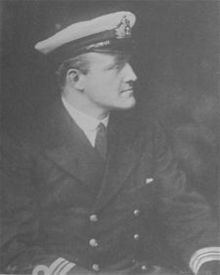Role Military officer Rank Lieutenant-Commander | Name Arthur Harrison Awards Victoria Cross | |
 | ||
Unit HMS LionHMS Vindictive | ||
Lieutenant-Commander Arthur Leyland Harrison VC (3 February 1886 – 23 April 1918) was an English Royal Navy officer, and World War I recipient of the Victoria Cross, the highest and most prestigious award for gallantry in the face of the enemy that can be awarded to British and Commonwealth forces.
Contents
Harrison was born in Torquay, Devon, and educated at Brockhurst Preparatory School, where he is remembered every Armistice Day and at Dover College. At school Harrison was a tremendous all-round games player and, whilst in the Navy, he played rugby union and was capped twice for England. He is the only England rugby international to have been awarded the VC.
First World War
He served aboard HMS Lion for most of the war, seeing action at Heligoland Bight and Dogger Bank. He also saw action at the Battle of Jutland, and was mentioned in despatches
VC action
Harrison was 32 years old, and a Lieutenant-Commander in the Royal Navy during the First World War when the following deed took place at the Zeebrugge Raid for which he was awarded the VC:
For most conspicuous gallantry at Zeebrugge on the night of the 22nd-23rd April, 1918. This officer was in immediate command of the Naval Storming Parties embarked in 'Vindictive'. Immediately before coming alongside the Mole Lieut.-Commander Harrison was struck on the head by a fragment of a shell which broke his jaw and knocked him senseless. Recovering consciousness he proceeded on to the Mole and took over command of his party, who were attacking the seaward end of the Mole. The silencing of the guns on the Mole head was of the first importance, and though in a position fully exposed to the enemy's machine-gun fire Lieut.-Commander Harrison gathered his men together and led them to the attack. He was killed at the head of his men, all of whom were either killed or wounded. Lieut.-Commander Harrison, though already severely wounded and undoubtedly in great pain, displayed indomitable resolution and courage of the highest order in pressing his attack, knowing as he did that any delay in silencing the guns might jeopardise the main object of the expedition, i.e., the blocking of the Zeebrugge-Bruges Canal.
His body was never recovered. He, along with three others who were missing in action on the Zeebrugge raid, are commemorated on the Zeebrugge Memorial, at the Zeebrugge Churchyard. He is also commemorated by a brass plaque, mounted in the Warrior Chapel at st Mary's Wimbledon.
The Medal
His mother Adelaide Ellen Harrison, who lived in Wimbledon, London, received the VC and in 1967 relatives donated it to the Britannia Royal Naval College, Dartmouth, Devon where it is on public display.
